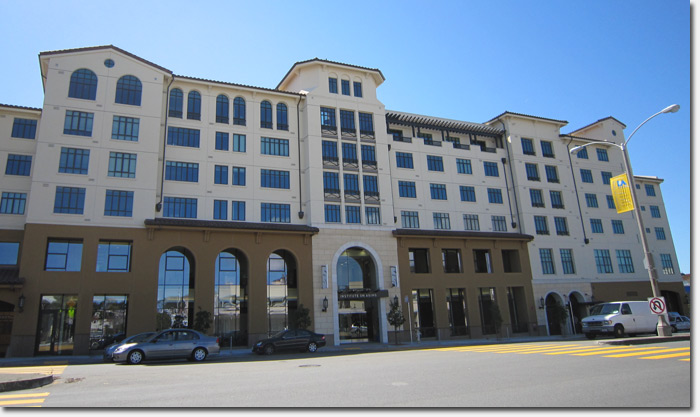
This Saturday will mark the official grand opening of the Institute on Aging’s (IOA) new Senior Campus, located at 3575 Geary near Arguello. The project first broke ground in 2008 and includes a 3-story, 50,000 square foot building that houses offices and health and social support programs for seniors, along with a 150-unit residential housing development, also for seniors.
The IOA has been around for 25 years and its mission is to help seniors live independently, or “age in place” as some refer to it. To further that mission, the IOA offers a comprehensive array of programs and services that seniors can participate in by visiting the campus. Some participants come on their own, others via IOA transit vans that pick them up from their homes. Some are dropped off by family members or caregivers.
Once at the IOA Senior Campus, clients have access to a myriad of programming and services including art programs, geriatric care, psychological counseling, and social day programs.
I was taken on a tour of the new Senior Campus recently, which will welcome the community this Saturday, April 2 to a grand opening and ribbon cutting ceremony from 11:30am until 2pm.
It’s unlike any senior center that I’ve ever visited. There’s plenty of natural light flooding in to the building, peaceful courtyards, lots of pleasant earth tones and other natural touches, as well as state-of-the-art facilities to facilitate the health and social support programs that IOA offers.
The light and airy front lobby immediately sets the tone of the new building, which was designed by architect Ignatius Tsang of Tsang Architecture. Tsang wanted the building to reflect on the cycle of life and the wisdom that comes with age. To illustrate that, Tsang implemented a circular design to the building whose centerpiece is a round, open courtyard. Even as you walk through the curved hallways, you notice a tiled ring that runs continuously around the bottom floor.
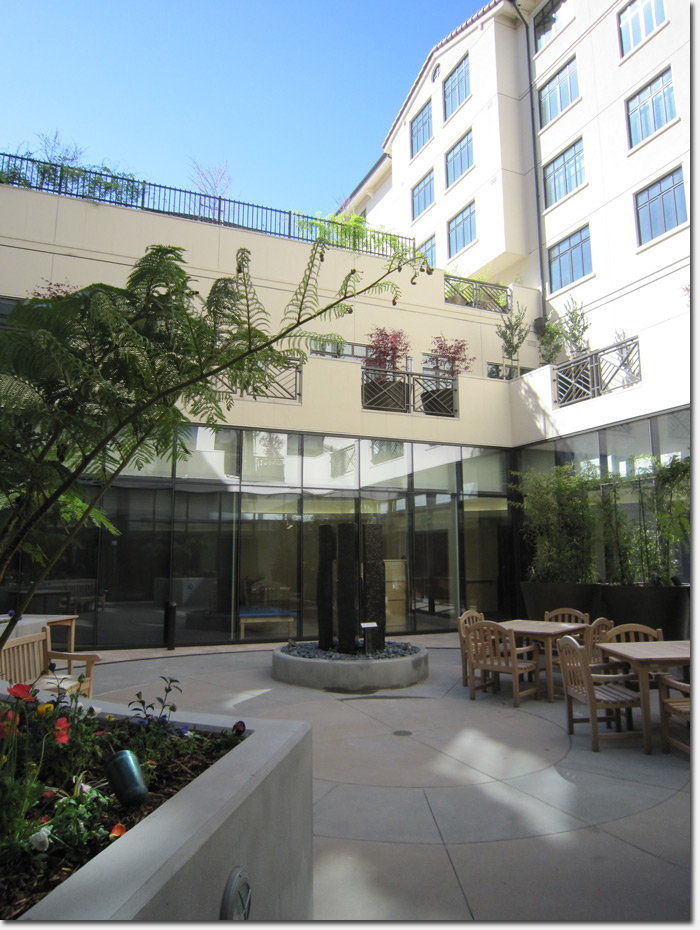
The center courtyard of the new IOA Senior Campus, complete with fountain.
Tsang also kept his primary audience in mind while putting on the finishing touches. As you walk around the building, you notice a variety of floor materials, colors and textures blended in together. I was told this was by design as many seniors look down at the floor to aid in walking, so Tsang wanted to ensure that their view was as interesting as possible.
Another of the building’s highlights is the “Tree of Life” mural by artist Neil Seth Levine, which you see as soon as you walk in the door. Composed of over 1 million tiny glass tiles, the mosaic runs from the basement level all the way up to the second floor, and depicts trees and leaves in different times of day and seasons. When you see it in person, it’s hard to believe it only took two and half weeks to construct.

The Tree of Life mural by artist Neil Seth Levine, as seen from the 2nd floor above the lobby.
Inset: a closeup of the tiny tiles that make up the mosaic.
The new Senior Campus was 10 years in the making and cost $100 million to build. The 50,000 square foot building includes 70 offices, 2 activity / rehabilitation rooms, 5 conference rooms, and a large meeting room / auditorium. About 140 IOA staff will work in the new campus building, many of whom are being brought in from other IOA offices. All but one of the five Geary Boulevard campuses of the IOA will be merged into the new senior campus. Only the 2700 Geary location will remain open.
$15 million of the project’s cost was funded by donations to the IOA from private donors, just 210 to be exact. Longtime San Francisco philanthropists Richard and Rhoda Goldman provided a lead donation of $2 million to the project. The IOA’s total fundraising goal for the project is $18 million, so they are still looking for donations to help retire the debt.
Next door at 3595 Geary are the Coronet Apartments, a new 150-unit, low-income, residential housing complex for seniors. It’s managed separately by Bridge Housing, who rents out the studio, 1-bedroom and 2-bedroom apartments for $450 to $700 per month. The apartments are expected to have their official opening in June; about 40 units are currently occupied.
53 of the Coronet Apartments are allocated to participants in IOA’s PACE (Program of All-Inclusive Care for the Elderly) program. PACE enables seniors with chronic health conditions to receive care in the community while continuing to live at home. In April, the IOA’s Senior Campus will open their PACE clinic, offering an array of medical services for PACE clients.
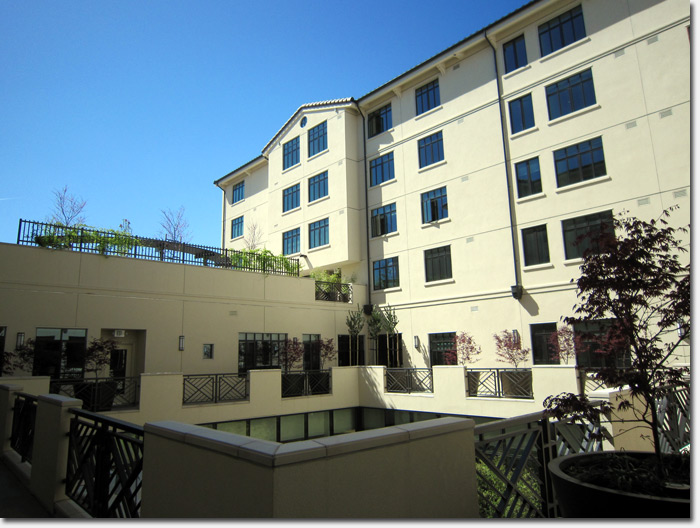
An outdoor area on the second floor. The Coronet Apartments overlook it from the right.
The new Senior Campus also includes a large meeting room on the lower level which the IOA has made available for public rental. The room includes a raised stage (with a wheelchair lift) and can hold up to 150 people. The room is also outfitted with full audio visual equipment. Revenues made from renting out the room will be put back into the IOA’s operating budget.
Also on the lower level are new class and storage rooms for the IOA’s Center for Elders and Youth in the Arts (CEYA) program. Art classes in poetry, dance, and the visual arts are taught around the Bay Area, some in collaboration with youth and youth organizations.
Aside from providing valuable art programming to seniors, CEYA also helps fund itself through its Corporate Art Lending program. The best works of art that come from CEYA participants are scanned, printed and framed in-house at the IOA, and are then lent out to corporations who pay a fee – $4,000 to $7,000 – to lease entire gallery exhibitions. The program offers complete gallery installations with themes like “San Francisco: Literal to Abstract”, “Time Changes” and “Flowers”.

One of the new CEYA storage rooms in the lower level. Those cabinets house the framed
prints that are part of the program’s Corporate Art Lending program.
In addition to being a valuable resource for seniors, the IOA also wants to be one for the community. The IOA mans a special phone hotline, 415-750-4111, that anyone can call with questions about senior health, aging, elderly care, anything really. There is an intake department at the new Senior Campus which answers the hotline and assists callers.
Janet Howell, Director of Communications and Marketing at the IOA told me they receive about 500 calls a month to the hotline, which is printed on senior literature that is distributed all over the Bay Area.
“We’d really like for the community to know that we are the premiere resource for aging. So whether or not we can help you personally, we should know who can,” Howell said.
To take a tour of the Institute of Aging’s new Senior Campus, stop by the grand opening event this Saturday from 11:30am until 2pm. For more information on the IOA, visit their website or call 750-4111.
Sarah B.
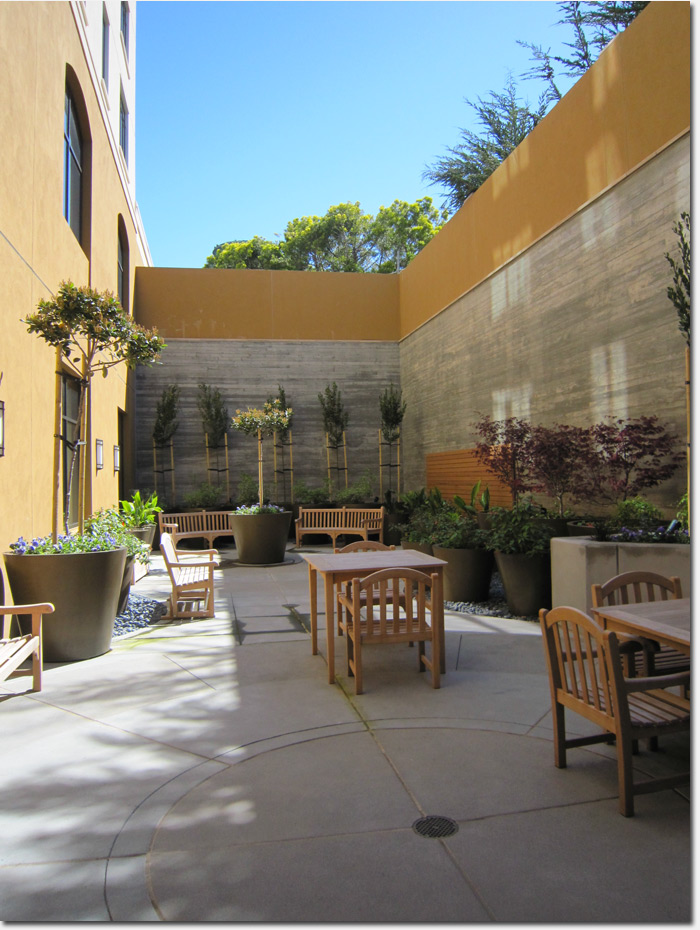
Another small courtyard off of one of the day program rooms.
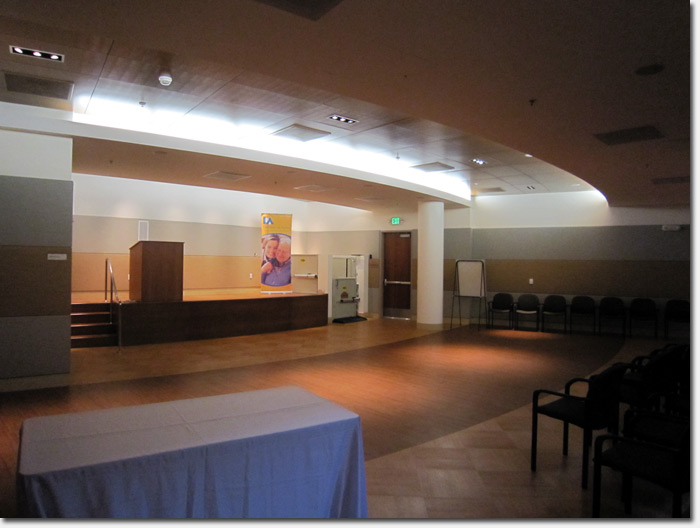
The large meeting room / auditorium that is on the lower level. Available for public rental.
woo hoo! 11 more years and I can use it!!
While this does look nifty, I’ll always miss the (actual) Coronet. It was my first job.
They should have put in a token film screening room…to reflect, albeit in a very very small way, the once might heritage of the Coronet (kind of like the Golden Gate Park putting in all that token greenery around the signage and paved paths).
That’s great that the designs are taking into account it’s most frequent users (keeping the floor interesting and all), but why does the courtyard look like an animal pen. What’s with the absurdly high walls?! Gotta keep grandma from escaping?
Westender: There is a 17 foot grade difference between Geary Blvd. and Almaden Court to the south. So the high walls were needed to secure the adjoining hillside. At the top of the grey concrete is where the yard of the adjoing neighbor’s home is. The rest of the (brown plaster) wall makes up the fence between the properties.
While I think the goldman Institute is a great organization and I’m sure that building is state of the art (I have visited many centers like these around the country), I can’t say that it really looks that great from the outside.
Nothing will replace the Coronet.